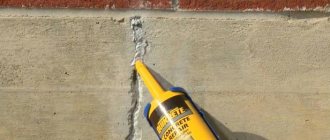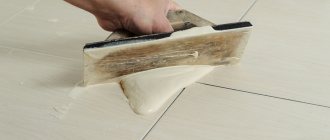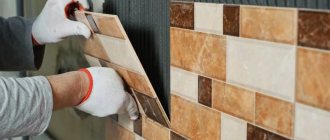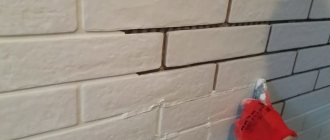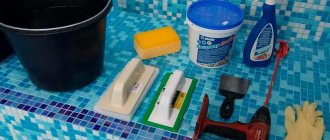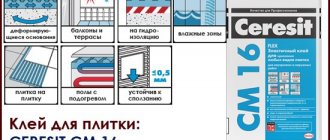Recommended grout joint width for tiles
| Tile size, mm | Seam width, mm |
| 20x20x4 | 2 |
| 50x50x4 | 2 |
| 75x150x6 | 3-5 |
| 100x100x6 | 3-5 |
| 100x100x10 | 3-5 |
| 100x200x6 | 3-5 |
| 100x200x10 | 5-10 |
| 150x150x6 | 3-5 |
| 200x200x8 | 3-5 |
| 120x240x12 | 5-10 |
| 250x250x12 | 5-10 |
| 250x250x20 | 5-20 |
| 250x330x8 | 3-10 |
| 300x300x8 | 3-10 |
| 300x300x10 | 3-10 |
| 300x300x20 | 5-20 |
| 300x600x10 | 3-10 |
| 330x330x10 | 3-10 |
| 400x400x10 | 3-10 |
| 450x450x12 | 5-10 |
| 500x500x12 | 5-10 |
| 600x600x12 | 5-10 |
Ceramic tile grout calculator
Good day to everyone who visited our site!
This article will discuss a problem that many craftsmen almost always encounter at the stage of indoor tiling work. The best solution would be to calculate the grout for the tiles using an online calculator.
The consumption of the mixture per 1 m² depends on the parameters of the joints, the shape of the tiles, the concentration of the mixture and the professional skills of the craftsman. For each case it is individual, but there is a formula that can be used to find out the approximate figure.
You will be required to enter the data in the appropriate column. You can easily find them out by measuring the room and the size of the tiles with a tape measure. Enter values:
Online grout consumption calculator
Explanations regarding calculating the amount of grout
Using a calculator, you can calculate the approximate value of the mixture in kg to understand how much you need to purchase for grouting. For example, it will give the figure 2.38 kg. This means you need to buy more grout based on the packaging options offered. Almost a third of materials are lost during work. The right decision would be to buy 3 kg of the composition. For greater customer convenience, they are sold packaged in bags of 1, 2 and 4 kg. Therefore, you need to take 1+2 kg = 3 kg. At the same time, you should not worry at all about the excess and try to save it to use after some time - a mixture that is not hermetically sealed will lose its original properties. If you apply a low-quality mixture to the walls, it will not last even a month.
Using our calculator, you can make calculations for both ceramic tiles and any porcelain tiles, tiles or mosaics. Now you don't need to look for a caliper to measure the width of the seam. It is enough to remember the type of crosses used at the installation stage. The most common is 2 mm.
Manufacturing standards
On all packaging, the manufacturer must indicate the approximate consumption of the mixture. This is not a very good solution, because not all dimensions of the material are recorded in the table. Below you can find several descriptions from popular manufacturers.
Grout consumption "Starateli"
| Tile size, mm | Seam width, mm | Consumption of dry mixture, kg/m² |
| 50x50x4 | 2 | 0,5 |
| 50x50x4 | 3 | 0,7 |
| 100x100x6 | 2 | 0,4 |
| 100x200x6 | 3 | 0,4 |
| 150x150x6 | 3 | 0,4 |
| 200x200x8 | 5 | 0,6 |
| 250x200x9 | 5 | 0,6 |
| 250x200x12 | 5 | 0,8 |
Grout consumption Ceresit CE33
| Tile size, mm | Seam width, mm | Consumption of dry mixture, kg/m² |
| 50x50 | 2 | 0,5 |
| 50x50 | 3 | 0,7 |
| 100x100 | 2 | 0,4 |
| 100x200 | 3 | 0,4 |
| 150x150 | 3 | 0,4 |
| 200x200 | 5 | 0,5 |
Well, that's all, dear site visitors. We believe that you are now convinced that such work does not involve any visible difficulties, and the process of performing calculations does not take much time thanks to the universal online assistant. There are also other calculators on our website, which you can familiarize yourself with by visiting the corresponding section.
Remember that if you doubt your own abilities, it is better to seek help from specialists, because this article is only a recommendation, and not step-by-step instructions. Good luck to you, friends!
Grout consumption for tile joints per 1m2 - cost standards
During installation, a small gap is left between the tiles. Typically it is 2-3 millimeters for walls, or 3-4 millimeters for floors. To prevent dirt from entering, it is necessary to seal these gaps and seams using special mixtures based on cement or epoxy resin.
Today there are many grout mixtures on the market, and the main manufacturers are Ceresit, Litokol, and Mapel. The consumption of these materials depends on:
- material density - the smaller the grain size of the material, the less grout consumption will be;
- size of ceramic tiles - the smaller the tile, the longer the length of the grout joint. In this sense, large tiles are more economical in terms of grout consumption;
- seam width and depth.
Calculation formula
To calculate the grout consumption for tiles per square, use the following formula:
R = ((DP + ShP) / (DP x ShP)) x ShSh x GSh x KPS
Where:
- DP and ШП are the length and width of the tile. Units of measurement are millimeters.
- ShSh and GSh are the width and depth of the seam. Units of measurement are millimeters. Please note that in most cases the joint depth (GD) coincides with the thickness of the tile. If the tiles were laid on a thick layer of cement, you need to add 1-2 millimeters to take into account the thickness of the installation layer.
- KPS is the grout density coefficient. Cement grouts usually have a coefficient of 1.7-2.1 units. Epoxy mixtures are less dense - for them the coefficient is usually 1.4-1.7 units.
Please note that if you apply the formula, you will receive grout expressed in grams. To get kilograms, you need to divide the resulting number by 1000.
How to calculate grout consumption for tiles? Manufacturers' recommendation
Regardless of how ceramic tiles are laid, the seams between them are filled with a special solution - grout. The seam method of laying tiles is more preferable than the butt joint method for a number of reasons: tiles laid in this way do not fall off, do not crack, look more aesthetically pleasing, and the seams hide all dimensional defects of ceramic elements. The ideal joint width for ceramic tiles measuring 15x15 cm is 1.5-2 mm, for flooring parts measuring 33x33 cm - 2-3mm. The grout must be selected in accordance with the tone of the tile.
Grouts for ceramic tiles are available in cement and epoxy bases. For traditional facing tiles, cement tile grout is used with a joint width within 6 mm. For swimming pools and special types of floors with a joint width of 4-16 mm, special grouts are used to ensure movement and deformation of the tiles without destroying the structure of the joint.
Grout consumption can be calculated depending on the area of the surface to be tiled and the size of the ceramic tile. For example, for a standard floor tile 30x30 cm, laid with a joint width of 2 mm, you will need 300 grams of grout per 1 m2 of area. The grouting solution is prepared in strict accordance with the manufacturer's instructions so that the resulting plastic mass fills the tile joints efficiently. For mosaic tiles of the usual size 5x5 cm and a joint width of 2 mm, about 1 kg of dry grout will be required, since such a significant expense is associated with the small size of the mosaic elements and a considerable number of joints.
Formula for calculating grout consumption for joints
(A+B)/(A*B)*C*D*F=Kg/m2 (+ margin 10-15%)
A – tile length (mm)
B – tile width (mm)
C – seam width (mm)
D – seam depth (mm)
F – volumetric weight of grout, approximately equal to 1.6
In order for the grout to obtain the desired consistency, it is necessary to use special latex or clean cool water, the temperature of which should be from +5 to +35C. The mixture is carefully mixed with a construction mixer at low speed to obtain a homogeneous mass without lumps. After the mixing process, a 5-10 minute pause is maintained, then the solution is mixed again, and only after this the grout is ready for use. Failure to comply with the proportions can lead to a deterioration in the physical and chemical properties of the grout and increase its consumption. To work with grout, you should use special tools - rubber spatulas, which are available in different sizes and configurations.
Material consumption table for joint fillers
What parameters should you pay attention to?
The consumption of the fugue is influenced by several factors:
- Density: depends on the formulation of the composition and its manufacturing technology. Manufacturers indicate this characteristic on the packaging container.
- The overall dimensions of the tile: its length, width and thickness determine the parameters of the seam.
- Seam width: recommendations for tiling work indicate the minimum allowable gaps between tiles. But designers often make them wider - up to 2-3 cm. The grout manufacturer must indicate in the instructions what width of joints this product is intended for.
- Seam depth: this parameter depends on the total thickness of the tile and the adhesive layer.
The grout not only holds it together, but also decorates the cladding. Depending on the chosen color and structure of the fugue, you can emphasize the contours of the styling pattern or make the seams invisible.
The second way is using an online calculator
Now, with the presence of a global network, it has become much easier and faster for many to find answers to any questions. This also applies to the ability to easily calculate the required amount of mortar for grouting tile joints in a certain area.
Using an online calculator, you can get a finished result in a matter of seconds, you just need to enter the data correctly. Such “helpers” can be found on many construction sites or on the pages of online stores.
To calculate, you are asked to enter:
- tile sizes;
- seam width;
- tile laying area.
When choosing this calculation method, it is recommended to remember that the more data you need to enter, the more accurate the calculations will be.
Length, width and thickness of tiles
According to overall dimensions, facing tiles are divided into:
- classic – with a side of 100-500 mm;
- small-sized - this group includes small chips (50x50 mm) used to create mosaic compositions;
- large-sized - with a side from 500 to 1200 mm.
Applying grout
Wall decoration, in most cases, is made with rectangular tiles with dimensions of 200x250 or 200x300 mm. But products with sides of 120x240, 150x200 and 150x150 mm are also often used.
The dimensions of the tiles are chosen to be a multiple of the dimensions of the surface to be finished. This method will reduce the amount of waste and reduce the labor intensity of cladding.
Application area
For which surfaces can the epoxy composition Litokol be used, consider:
- For covering surfaces in rooms with high humidity. These are bathtubs, showers, saunas, swimming pools.
The photo shows epoxy grout for a sauna. - When treating kitchen work surfaces, including the apron above the work area and the sink.
- For cladding and finishing of balconies and terraces. Attention: this method is suitable for those areas where the temperature in winter does not drop below minus 20 degrees. If it gets colder, the grout may not hold up.
- Floors with a heating system are also suitable for covering them with slabs with Litokol grout.
- For finishing cheese factories, mud baths, industrial complexes and other premises.
But what kind of grout for floor tiles in the bathroom is most often used is described in this article.
This article will help you understand which moisture-resistant grout for joints is the best and what criteria should be used to choose it.
How to use grout for tiles in a Ceresit bathroom and how exactly to use it is described here in the article: https://resforbuild.ru/sypuchie-materialy/zatirka/kakaya-zatirka-dlya-plitki-v-vannoj-luchshe.html
You may also be interested in learning how ceresit ce 33 super grout is used.
Comparative table of grout consumption rates from different manufacturers, kg/m2
The grout consumption table for tiles looks like this:
| Length, width and thickness of tiles (centimeters) | Grout brand | Approximate grout consumption rate (kg per meter2) |
| 10 x 10 x 0.6 | Ceresit | 0,21 |
| Litokol | 0,19 | |
| Mapel | 0,18 | |
| 20 x 20 x 0.8 | Ceresit | 0,14 |
| Litokol | 0,12 | |
| Mapel | 0,13 | |
| 30 x 30 x 0.6 | Ceresit | 0,07 |
| Litokol | 0,06 | |
| Mapel | 0,07 | |
| 40 x 40 x 0.8 | Ceresit | 0,07 |
| Litokol | 0,06 | |
| Mapel | 0,07 | |
| 60 x 60 x 1 | Ceresit | 0,06 |
| Litokol | 0,05 | |
| Mapel | 0,06 |
Please note that the table shows grout consumption rates for sealing a 1 mm thick seam . If you are dealing with a thicker seam, then you need to multiply the corresponding number from the table by the thickness value.
For example, you want to seal a 3 millimeter thick seam using a Ceresit mixture, where the tile parameters are 20 x 20 x 0.8 centimeters.
The tile grout consumption table states that the consumption rate in this case is 0.14 kg. Since the layer thickness is 3 millimeters, you need to multiply 0.14 by 3, which will be equal to 0.52. That is, the grout consumption in this case will be 0.52 kg per square meter of wall.
The first method is mathematical
To calculate the required amount of grout mixture, the formula is successfully used: (A+B)/(A*B)*C*D*K = Kg/M2
For those who remember the procedure for calculating a formula from school mathematics lessons, it will not be difficult to find the meaning of the expression given the following data:
- tile length (value A);
- tile width (value B);
- width of the seam between the tiles (value C);
- thickness of the tile element (value);
- coefficient 1.6 (solution density).
In our example, the dimensions indicated in mm correspond to: A=300mm, B=300mm, C=2mm and D=4mm.
Substituting the values into the formula, we get:
(300+300)/(300*300)*2*4*1.6 = 0.085 kg/m²,
that is, in order to grout the seams, you will need 85 g of ready-made mortar for each square meter of area.
But to take into account various unforeseen expenses, experts recommend adding 10-15 percent to the result obtained.
We calculate the percentage of the number: 0.085 kg/m² * 15/100 = 0.012 kg/m², and add to the result obtained initially:
0.085 kg/m²+0.012 kg/m²=0.097 kg/m², in other words - almost 100g of solution per 1 sq.m.
Having a tiled laying area of, say, 6 square meters, we can make the final calculation:
6 sq.m*0.097kg/m²=0.582 kg/m².
It turns out that to grout the entire wall you need to prepare about 600 g.
In a similar way, you can calculate for tiles of any size, for example, grout consumption for a 600x600 tile:
(600+600)/(600*600)*2*4*1.6 = 0.043 kg/m², and calculate the 15% added just in case: 0.043 kg/m² *15/100=0.0065 kg/m²
As a result: 0.043 kg/m²+0.0065 kg/m=0.0495 kg/m², that is, 50g of solution per 1 sq.m
Comparing the two calculations, it becomes clear that the larger the size of each tiled element, the less mortar is required for grouting. In our examples, the size of the tile in the second case was twice as large as in the first, and the mortar for grouting it would require half as much.
But in order for the calculation to be as accurate as possible, it is necessary to prepare the solution strictly following the instructions, since errors entail a change in the characteristics and properties of the resulting material, and, consequently, its consumption.
Density coefficients of solutions
| Brand | Solution density coefficient, kg/dm3 |
| CERESIT CE 33 Super | 1.75 |
| KERAKOLL Fugalite Eco | 1.55 |
| KESTO Kiilto | 1.60 |
| LITOKOL Litochrom | 1.90 |
| LITOKOL Litochrom Luxury | 1.90 |
| LITOKOL Starlike | 1.55 |
| MAPEI Ultracolor Plus | 1.60 |
| MAPEI Kerapoxy Design | 1.60 |
We calculate the consumption of Ceresit grout
When calculating the required amount of Ceresit grout, a density coefficient of 1.75 is taken into account. It is the same for all types of mixture.
Thus, let’s calculate the consumption of Ceresite:
| Tile length, mm | 200 |
| Tile width, mm | 200 |
| Tile thickness, mm | 6 |
| Seam width, mm | 5 |
| Estimated area, m2 | 3 |
| Solution density coefficient, | 1,75 |
| Consumption, kg | 1,57 |
Ceresit mixture is sold in packages of 2 and 5 kg. So, for an area of 3 m2 it is enough to buy one package of 2 kg.
How to calculate grout for joints when tinting a mixture?
When tinting grout, the intensity of the shade is determined by the amount of dye added to a certain volume of base white grout.
Light shades of colored grout are obtained by adding literally 3 grams of color per 1 kg of dry mixture. With such proportions, the dye increases the weight of the grout very slightly - by 0.3%.
Saturated shades are obtained by adding 30 grams of dye per 1 kg of base mixture. In this case, the mass fraction of the dye is 3%.
From which the obvious conclusion follows: when tinting the grout yourself, it is permissible to neglect the mass fraction of the dye and not take it into account when calculating consumption.
Calculation of grout consumption: formula
You can calculate the required amount of fugue (Рз) using the formula:
Pz = M x K, where
- M – seam length (m/m2)
- K – grout consumption coefficient in g.
The length of the seam M per 1 m2 of tile covering is calculated using the formula:
M = (A + B)/A x B) , where
A and B – length and width of the tile, in m
Coefficient K = W x D x P , where
- W and D – width and depth of the seam in mm
- P – density or volumetric weight of the fugue.
It is recommended to increase the obtained result by 10%.
The third way is practical
Now let's consider the option of how to calculate grout for tiles without mathematical formulas and global network services. The practical calculation method has one undeniable advantage: the data obtained already includes all additional and unforeseen conditions, which were taken into account purely theoretically in the first two methods.
This calculation method consists of the following:
- 100g of mortar is prepared and completely used for grouting the joints in the tiles.
- The area of the treated tile installation is then measured.
- And the resulting ratio is taken as the basis for further calculation of the amount of solution that is necessary to treat the entire remaining area.
In order for this calculation method to be as accurate as possible, it is recommended to follow several grouting rules:
- the first portion of the solution, however, like all others, must be prepared strictly following the manufacturer’s instructions;
- grouting must be done with the same spatula throughout the entire work;
- if tiles of different sizes were laid on the area, then the calculation must be made individually for each option. The same applies to the grout consumption of wall and floor tiles, since not only are the sizes of the individual elements different, but the thickness of the tiles is also significantly different, and therefore the depth of the seams.
But in cases where there is no free access to the Internet, or there is no time to do mathematical calculations, and the practical method is not applicable due to the already small area of the laid tiles, ready-made calculations will be useful.
How to save money?
Grouting material is quite an expensive product. In order not to overpay money on an over-purchased fugu, you need to do careful preparatory work. Before laying the tiles, the floor or walls are leveled to the highest possible limits. The smoother the base, the less grout will go into the seams between the tiles. It is better to prepare the grouting material by hand rather than using auxiliary tools (for example, a mixer). This will make it possible to thoroughly knead the solution without natural loss, since a certain amount remains on the mixer.
Average amount of grout per square meter
Mixtures for filling joints are sold in two versions:
- Ready composition: has a thick consistency. This grout is packaged in plastic buckets. They are completely ready for use. They must be used quickly, since the evaporation of the liquid component leads to a change in the properties of the material.
- Dry powder: before use, it is diluted with latex or water in certain proportions specified by the manufacturer. You can prepare the working mixture in small portions.
The consumption of mixtures of different brands differs slightly. Therefore, it is quite appropriate to talk about the average grout requirement per square meter of tile cladding. The main factors are the overall dimensions of the tiles, the width and depth of the gaps between the tiles.
Table: grout consumption for some tile sizes, taking into account joint parameters, kg/m2
| Tile dimensions, mm | Width of intertile gap (seam), mm | |||||
| 2 | 3 | 5 | 8 | 10 | 15 | 20 |
| mosaic | 1,3 | |||||
| 75x150x6 | 0,6 | 1,0 | ||||
| 100x1000x10 | 1,0 | 1,6 | ||||
| 100x200x10 | 1,2 | 1,9 | 2,4 | |||
| 250x250x12 | 0,8 | 1,2 | 1,5 | |||
| 250x250x20 | 1,3 | 2,0 | 2,6 | 3,8 | 5,1 | |
| 300x300x8 | 0,3 | 0,4 | 0,7 | 0,9 |
The table shows the consumption rate of the dry mixture. Diluted with water or latex according to the recipe, the fugue will have more weight.
Based on the data in the table, the average width needed to fill joints is:
- 2 mm from 1 to 1.3 kg/m2;
- 3 mm – 0.3 – 1.6 kg/m2;
- 5 mm – from 0.4 to 1.9 kg/m2, etc.
Grout consumption is directly dependent on the width of the seam and inversely dependent on the dimensions of the tile.
How to use an online calculator?
In a given table, you need to enter the length, width, thickness of the tiles, as well as the width of the seam and the density of the grout. Click on the “calculate” button and get an instant effective result. Of course, the table does not take into account error percentages (tile unevenness, cutting to pipes, condition of the facing surface). Only on an individual basis will the master be able to eliminate minor errors in advance, as well as simulate the result in an advantageous position. Thus, calculating the amount of grout for tiles will not be difficult, and most importantly, quickly and efficiently.
Jointer tools
The following tools are used in jointing work:
- different types of spatulas, which are used to clean surfaces of glue, apply and distribute the fugue, and smooth seams;
- containers for water and mixing the mixture;
- kneading spatula;
- foam sponge;
- gloves;
- pliers;
- sandpaper.
The solution is prepared in small portions; its consistency should resemble thick sour cream. Remove the crosses and remaining glue between the tiles from the wall. Using a rubber spatula, carefully fill the space between the tiles with a fugue. Excess solution is immediately removed with a foam sponge. The filled joints are left to dry and then polished with fine sandpaper.

